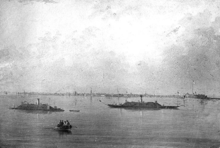CSS Palmetto State
 A wash drawing of Palmetto State by R. G. Skerrett
| |
| History | |
|---|---|
| Name | Palmetto State |
| Namesake | Nickname of South Carolina |
| Laid down | January 1862 |
| Launched | September 1862 |
| Commissioned | September 1862 |
| Fate | Scuttled and burned, 18 February 1865 |
| General characteristics | |
| Class and type | ironclad |
| Length |
|
| Beam | 43 ft (13.1 m) |
| Draft | 12 ft (3.7 m) |
| Depth of hold | 12 ft (3.7 m) |
| Installed power | 2 × fire-tube boilers |
| Propulsion |
|
| Speed | 6–7 knots (11–13 km/h; 6.9–8.1 mph) |
| Complement | 120 officers and men |
| Armament |
|
| Armor | Casemate: 4 in (102 mm) |
CSS[Note 1] Palmetto State was one of six Richmond class casemate ironclad rams built for the Confederate States Navy during the American Civil War. Completed in 1862, she defended Charleston, South Carolina and was burnt in 1865 to prevent her capture by advancing Union troops.
Background and description

The ship was built to a design by the Chief Naval Constructor,
The propulsion systems of the Richmond-class ironclads were different for each of the ships, often depending on what could be sourced locally. Palmetto State's pair of single-cylinder, direct-acting steam engines were taken from the gunboat CSS Lady Davis serving in Charleston. They used steam provided by a pair of horizontal fire-tube boilers built by the locally based Cameron & Company to drive a 8-or-10-foot (2.4 or 3.0 m) propeller. The boilers were probably 11 feet (3.4 m) tall, 10 feet (3.0 m) long, and 6 feet 9 inches (2.1 m) wide. The ironclad had a speed of 6–7 knots (11–13 km/h; 6.9–8.1 mph)[6][7] and a crew of 120.[5]
Palmetto State was initially armed with one 7-inch (178 mm)
Her casemate armor was 4 inches (102 mm) thick, backed by 22 inches (559 mm) of wood, while 2 inches (51 mm) of iron armor was used everywhere else.
Construction and career

Named for the nickname of
Before dawn on 31 January 1863 Palmetto State and her
Palmetto State also joined in the defense of Charleston during
Palmetto State was later set afire by the Confederates to avoid capture upon the evacuation of Charleston on 18 February 1865.
Notes
Citations
References
- Bisbee, Saxon T. (2018). Engines of Rebellion: Confederate Ironclads and Steam Engineering in the American Civil War. Tuscaloosa, Alabama: University of Alabama Press. ISBN 978-0-81731-986-1.
- Canney, Donald L. (2015). The Confederate Steam Navy 1861-1865. Atglen, Pennsylvania: Schiffer Publishing. ISBN 978-0-7643-4824-2.
- Koehler, R. B. & Sileo, Thomas (2008). "Question 40/43: Fates of Confederate Ironclads". Warship International. XLV (4): 276–277. ISSN 0043-0374.
- "Palmetto State". Dictionary of American Naval Fighting Ships. Naval History and Historical Command. Retrieved June 21, 2022.
- Silverstone, Paul H. (2006). Civil War Navies 1855–1883. The U.S. Navy Warship Series. New York: Routledge. ISBN 0-415-97870-X.
- Silverstone, Paul H. (1984). Directory of the World's Capital Ships. New York: Hippocrene Books. ISBN 0-88254-979-0.
- Still, William N. Jr. (1985) [1971]. Iron Afloat: The Story of the Confederate Armorclads. Columbia, South Carolina: University of South Carolina Press. ISBN 0-87249-454-3.
